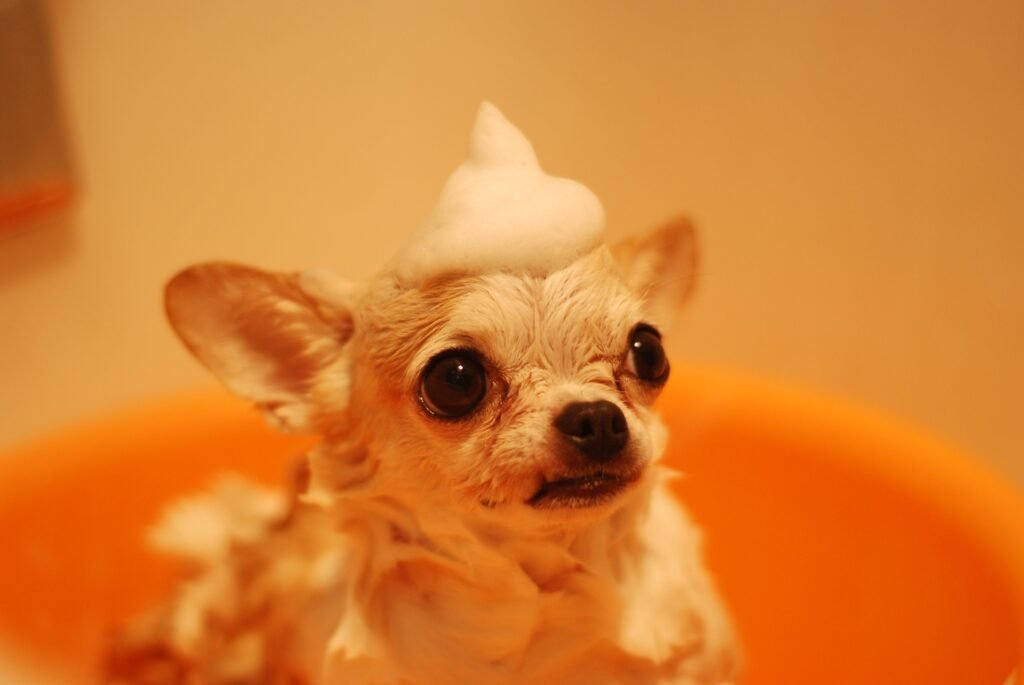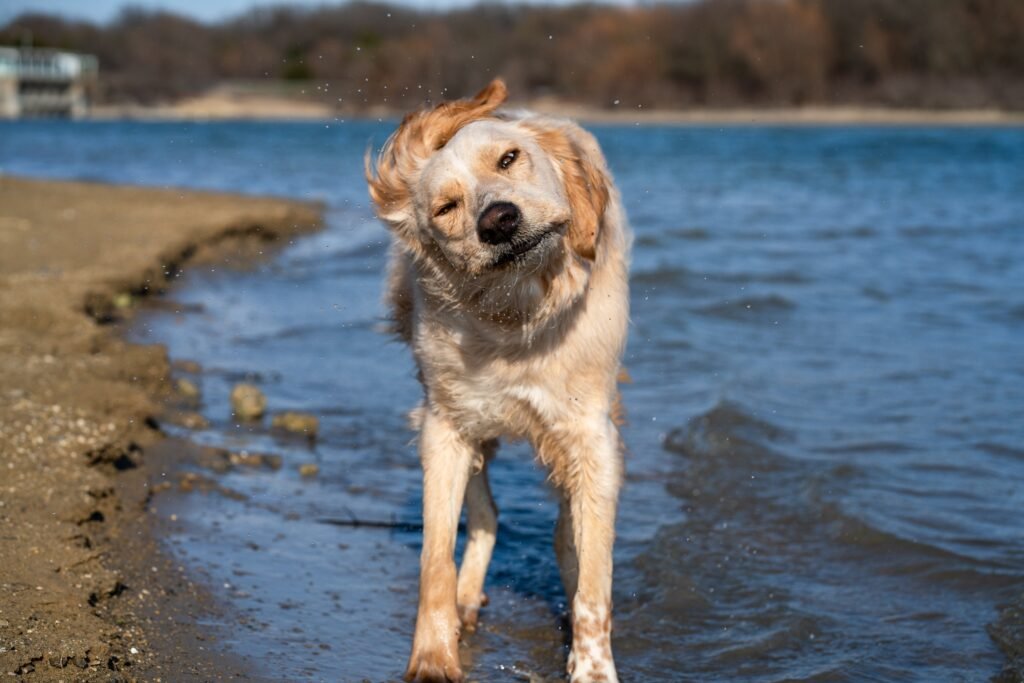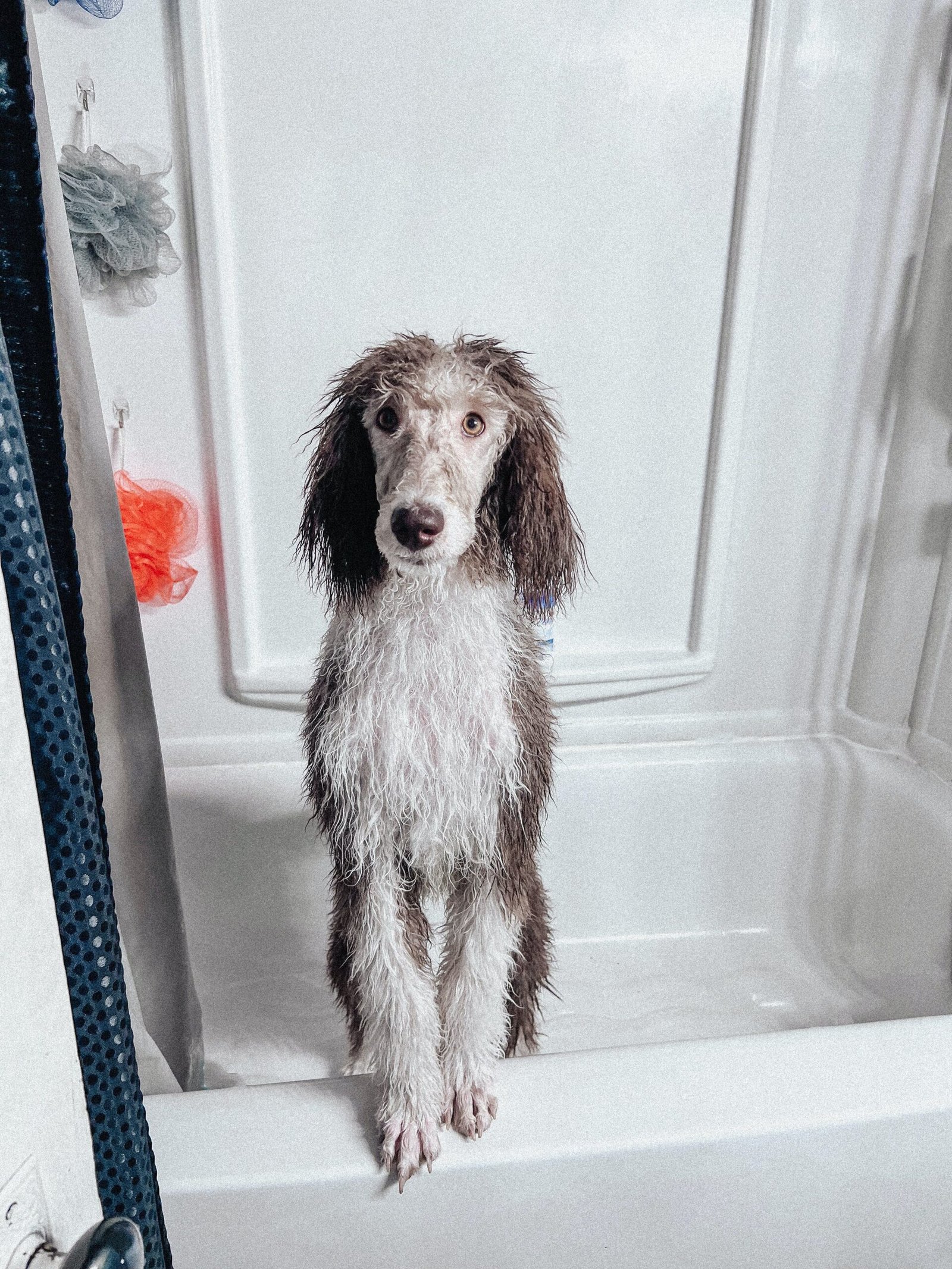Bathing your dog can be a fun bonding experience or a challenging chore, depending on their attitude toward water. This comprehensive guide covers everything you need to know to make bath time enjoyable for both of you. We’ll discuss how to prepare your bathroom for a doggy spa day, deal with reluctant or fearful pups, handle those post-bath zoomies, and more. With these tips on shampoos, towels, treats, and techniques, you can turn bath time into a happy, tail-wagging adventure full of suds and splashes!
Table of Contents
Preparing for Bath Time
Before you start bathing your dog, make sure you have all your bath essentials in one place. Nothing is more chaotic than having to carry your wet, zoomified dog down the hallway just to grab a towel that you missed out! Having everything within reach ensures a smooth and stress-free bath time for both you and your canine companion.
- Non-slip mat: This is to ensure you do not slip on the bathroom floor after your dog performs The Great Shake-Off (see below)
- Dog Shampoo: You can’t have a shower without shampoo!
- Towel: A towel often dries your dog faster than air-drying
- Emotional Support Toy: Puppies may need a toy to keep them distracted as you shower them
- Brushes/ Combs/ Hairdryer: Brushing and blowdrying your dog helps it dry faster, and also helps to smoothen tangled coats (for dogs with curly fur!)
Set a relaxing atmosphere for your dog. Consider the lighting—soft, ambient light can help soothe nervous pups. Play some calming music in the background and offer a few treats to create positive associations. Remember, the goal is to turn bath time into a bonding experience rather than a dreaded chore.
How Often Should You Bathe Your Dog?
“How frequently a pet needs a bath greatly varies based upon their breed, lifestyle, length of coat, and how much homework a pet owner is willing to do,” says Beth Cristiano, owner of Pretty Paws LLC, headquartered in Harrison, N.Y.
Considering Breed and Coat Type: Not all dogs are created equal, and neither are their coats. Different breeds and coat types have unique bathing requirements. Long-haired breeds may need more frequent baths to prevent matting, while short-haired breeds might get by with less frequent washing. Research your dog’s breed and coat type to tailor your bathing routine to their specific needs.
Skin Conditions: Certain skin conditions in dogs, such as seborrhea, may warrant more frequent showers to reduce itchiness for the dog.
Active Lifestyle: If your dog leads a more active lifestyle e.g. going on walks everyday, frolicking in muddy waters/ roads, then a more frequent shower regime would be better to ensure cleanliness of the dog’s skin and paws. After all, you also wouldn’t want to get mud on your furniture after a long walk!
Understanding Your Dog’s Needs
Taking Age and Health into Account: Consider your dog’s age and health when planning bath frequency. Puppies generally need gentler, less frequent baths to avoid stripping their delicate skin of essential oils. Older dogs or those with health conditions may also require special considerations, such as warmer water and a softer touch during the bathing process.
Choosing the Right Shampoo: Selecting the right shampoo is crucial for a successful bath. Opt for a dog-specific shampoo that matches your pup’s needs, whether it’s for sensitive skin, odor control, or flea prevention. Avoid using human shampoo, as it can disrupt your dog’s natural pH balance and cause skin irritation.
Ear and Eye Protection: During the bath, be cautious around your dog’s ears and eyes. Use a washcloth or a damp cotton ball to gently clean the area around the eyes, and avoid getting water or shampoo directly into the ears, as this can cause discomfort or infections.
Avoiding Water in Sensitive Areas: Dogs have sensitive areas, and some may not appreciate water near their face. Take extra care around the eyes, nose, and mouth, using a gentle touch and avoiding any unnecessary stress during the bath.

How to Bathe Your Dog
Step-by-Step Bathing Process:
- Prep Time: Brush your dog before the bath to remove loose hair and tangles.
- Prepare the Tub: Fill the tub with lukewarm water. Test the temperature with your wrist to ensure it’s comfortable.
- Start Rinsing: Gently introduce your dog to the water, offering treats and praise for positive reinforcement.
- Shampoo: Wet your dog thoroughly, then apply dog-friendly shampoo. Start from the neck and work your way down, avoiding the ears and eyes.
- Massage Time: Massage the shampoo into your dog’s coat, paying attention to any dirty or smelly areas. Use a washcloth for the face.
- Rinse and Repeat: Rinse your dog thoroughly, ensuring all soap is washed away. Leftover soap residue can cause skin irritation.
- The Great Shake-Off: Prepare for the post-bath shake! Be ready with a few towels to catch the spray.
- Towel Time: Gently towel-dry your dog, removing as much moisture as possible.

Important Tips for a Successful Dog Bath
Managing Water Temperature: Dogs are not fans of extreme temperatures. Ensure the water is comfortably warm—think of it as preparing a baby’s bath. Too hot or too cold can lead to a stressed-out pooch and a less-than-enjoyable bathing experience.
Easing Your Dog into the Bath: If your dog is new to the bathing scene or has had negative experiences in the past, take it slow. Start with short sessions, gradually increasing the time as your dog becomes more comfortable. Use positive reinforcement with treats and praise to create positive associations with bath time.
Using Positive Reinforcement: Turn bath time into a positive experience by showering your dog with praise, treats, and affection. Positive reinforcement helps your dog associate bath time with good things, making future sessions more enjoyable for both of you.
Drying and Post-Bath Care
Choosing the Right Towel: Not all towels are created equal when it comes to doggy drying. Opt for absorbent towels to soak up moisture efficiently. If your dog has a thick coat, consider using a chamois or a high-quality microfiber towel to speed up the drying process.
Dealing with the Shake-off: The inevitable post-bath shake is a force to be reckoned with. To minimize the waterworks, be prepared with towels and stand clear of the splash zone. Embrace the chaos, and maybe have a good laugh—after all, it’s a sign of a job well done!
Brushing and Grooming Post-Bath: Once your dog is dry, take the opportunity for a little post-bath grooming session. Brushing helps remove any remaining loose hair and prevents mats and tangles. Plus, it’s an excellent bonding activity between you and your freshly bathed pup.
Make Bath Time An Enjoyable Time!
Bathing your dog is more than a chore; it’s an opportunity to strengthen the bond between you and your furry friend. With the right approach, a bit of patience, and maybe a treat or two, bath time can become a positive and enjoyable experience for both you and your pup. So, lather up, splash around, and revel in the joy of a clean, happy, and refreshed canine companion! 🛁🐾
Common FAQs About Dog Bathing
How often should I bathe my dog?
The frequency of baths depends on your dog’s breed, coat type, and lifestyle. In general, most dogs benefit from a bath every two to three months, but more frequent baths may be necessary for certain breeds or if your dog loves outdoor adventures.
What if my dog hates water?
If your dog is water-averse, start by introducing them to water gradually. Use positive reinforcement, offer treats, and make bath time a positive experience. Consider using a gentle approach, like a damp washcloth, before progressing to a full bath.
How do I prevent my dog from shaking water everywhere?
While you can’t completely prevent the post-bath shake, having towels ready and standing clear of the immediate splash zone can help minimize the water spray. Embrace the shake and consider it a post-bath celebration!
What if my dog has fleas?
If your dog has fleas, choose a flea-specific shampoo or consult with your veterinarian for recommended flea control products. It’s important to treat the entire environment to eliminate fleas effectively.
How do I clean my dog’s ears during bath time?
Use a damp cotton ball or a washcloth to gently wipe around the external part of your dog’s ears. Avoid inserting anything into the ear canal. If your dog has excessive earwax or signs of infection, consult with your veterinarian for proper ear care.
What if my dog has sensitive skin?
If your dog has sensitive skin, choose a hypoallergenic or oatmeal-based shampoo. Test a small patch before the full bath to ensure your dog doesn’t have an adverse reaction. Additionally, consult with your veterinarian for recommendations on products suitable for sensitive skin.
Bathing your dog is more than a chore; it’s an opportunity to strengthen the bond between you and your furry friend. With the right approach, a bit of patience, and maybe a treat or two, bath time can become a positive and enjoyable experience for both you and your pup. So, lather up, splash around, and revel in the joy of a clean, happy, and refreshed canine companion! 🛁🐾








